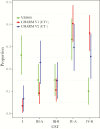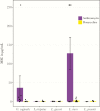Nonoptimal Vaginal Microbiota After Azithromycin Treatment for Chlamydia trachomatis Infection
- PMID: 31573603
- PMCID: PMC7530545
- DOI: 10.1093/infdis/jiz499
Nonoptimal Vaginal Microbiota After Azithromycin Treatment for Chlamydia trachomatis Infection
Abstract
We characterized the composition and structure of the vaginal microbiota in a cohort of 149 women with genital Chlamydia trachomatis infection at baseline who were followed quarterly for 9 months after antibiotic treatment. At time of diagnosis, the vaginal microbiota was dominated by Lactobacillus iners or a diverse array of bacterial vaginosis-associated bacteria including Gardnerella vaginalis. Interestingly, L. iners-dominated communities were most common after azithromycin treatment (1 g monodose), consistent with the observed relative resistance of L. iners to azithromycin. Lactobacillus iners-dominated communities have been associated with increased risk of C. trachomatis infection, suggesting that the impact of antibiotic treatment on the vaginal microbiota could favor reinfections. These results provide support for the dual need to account for the potential perturbing effect(s) of antibiotic treatment on the vaginal microbiota, and to develop strategies to protect and restore optimal vaginal microbiota.
Keywords: Chlamydia trachomatis; 16S rRNA gene sequencing; antibiotics; longitudinal; sexually transmitted infection; vaginal microbiome.
© The Author(s) 2019. Published by Oxford University Press for the Infectious Diseases Society of America.
Figures






References
-
- Centers for Disease Control and Prevention. Sexually transmitted disease surveillance 2017. Atlanta, GA: CDC, 2018.
-
- Centers for Disease Control and Prevention. STD rates by age https://www.cdc.gov/std/stats18/adolescents.htm Accessed 3 July 2019.

